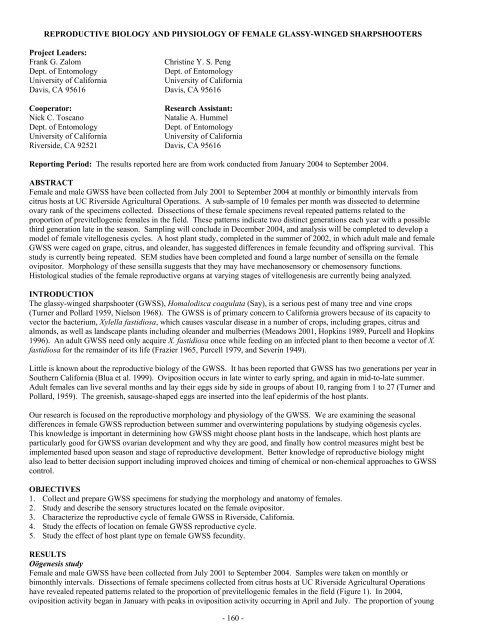Impact Of Host Plant Xylem Fluid On Xylella Fastidiosa Multiplication ...
Impact Of Host Plant Xylem Fluid On Xylella Fastidiosa Multiplication ...
Impact Of Host Plant Xylem Fluid On Xylella Fastidiosa Multiplication ...
Create successful ePaper yourself
Turn your PDF publications into a flip-book with our unique Google optimized e-Paper software.
REPRODUCTIVE BIOLOGY AND PHYSIOLOGY OF FEMALE GLASSY-WINGED SHARPSHOOTERS<br />
Project Leaders:<br />
Frank G. Zalom<br />
Dept. of Entomology<br />
University of California<br />
Davis, CA 95616<br />
Cooperator:<br />
Nick C. Toscano<br />
Dept. of Entomology<br />
University of California<br />
Riverside, CA 92521<br />
Christine Y. S. Peng<br />
Dept. of Entomology<br />
University of California<br />
Davis, CA 95616<br />
Research Assistant:<br />
Natalie A. Hummel<br />
Dept. of Entomology<br />
University of California<br />
Davis, CA 95616<br />
Reporting Period: The results reported here are from work conducted from January 2004 to September 2004.<br />
ABSTRACT<br />
Female and male GWSS have been collected from July 2001 to September 2004 at monthly or bimonthly intervals from<br />
citrus hosts at UC Riverside Agricultural Operations. A sub-sample of 10 females per month was dissected to determine<br />
ovary rank of the specimens collected. Dissections of these female specimens reveal repeated patterns related to the<br />
proportion of previtellogenic females in the field. These patterns indicate two distinct generations each year with a possible<br />
third generation late in the season. Sampling will conclude in December 2004, and analysis will be completed to develop a<br />
model of female vitellogenesis cycles. A host plant study, completed in the summer of 2002, in which adult male and female<br />
GWSS were caged on grape, citrus, and oleander, has suggested differences in female fecundity and offspring survival. This<br />
study is currently being repeated. SEM studies have been completed and found a large number of sensilla on the female<br />
ovipositor. Morphology of these sensilla suggests that they may have mechanosensory or chemosensory functions.<br />
Histological studies of the female reproductive organs at varying stages of vitellogenesis are currently being analyzed.<br />
INTRODUCTION<br />
The glassy-winged sharpshooter (GWSS), Homalodisca coagulata (Say), is a serious pest of many tree and vine crops<br />
(Turner and Pollard 1959, Nielson 1968). The GWSS is of primary concern to California growers because of its capacity to<br />
vector the bacterium, <strong>Xylella</strong> fastidiosa, which causes vascular disease in a number of crops, including grapes, citrus and<br />
almonds, as well as landscape plants including oleander and mulberries (Meadows 2001, Hopkins 1989, Purcell and Hopkins<br />
1996). An adult GWSS need only acquire X. fastidiosa once while feeding on an infected plant to then become a vector of X.<br />
fastidiosa for the remainder of its life (Frazier 1965, Purcell 1979, and Severin 1949).<br />
Little is known about the reproductive biology of the GWSS. It has been reported that GWSS has two generations per year in<br />
Southern California (Blua et al. 1999). Oviposition occurs in late winter to early spring, and again in mid-to-late summer.<br />
Adult females can live several months and lay their eggs side by side in groups of about 10, ranging from 1 to 27 (Turner and<br />
Pollard, 1959). The greenish, sausage-shaped eggs are inserted into the leaf epidermis of the host plants.<br />
Our research is focused on the reproductive morphology and physiology of the GWSS. We are examining the seasonal<br />
differences in female GWSS reproduction between summer and overwintering populations by studying oögenesis cycles.<br />
This knowledge is important in determining how GWSS might choose plant hosts in the landscape, which host plants are<br />
particularly good for GWSS ovarian development and why they are good, and finally how control measures might best be<br />
implemented based upon season and stage of reproductive development. Better knowledge of reproductive biology might<br />
also lead to better decision support including improved choices and timing of chemical or non-chemical approaches to GWSS<br />
control.<br />
OBJECTIVES<br />
1. Collect and prepare GWSS specimens for studying the morphology and anatomy of females.<br />
2. Study and describe the sensory structures located on the female ovipositor.<br />
3. Characterize the reproductive cycle of female GWSS in Riverside, California.<br />
4. Study the effects of location on female GWSS reproductive cycle.<br />
5. Study the effect of host plant type on female GWSS fecundity.<br />
RESULTS<br />
Oögenesis study<br />
Female and male GWSS have been collected from July 2001 to September 2004. Samples were taken on monthly or<br />
bimonthly intervals. Dissections of female specimens collected from citrus hosts at UC Riverside Agricultural Operations<br />
have revealed repeated patterns related to the proportion of previtellogenic females in the field (Figure 1). In 2004,<br />
oviposition activity began in January with peaks in oviposition activity occurring in April and July. The proportion of young<br />
- 160 -











